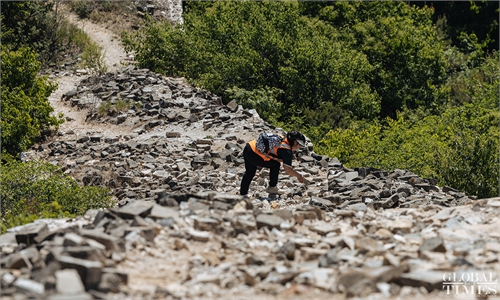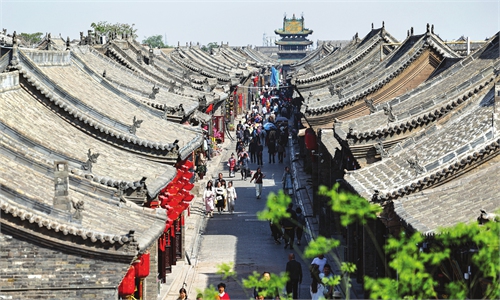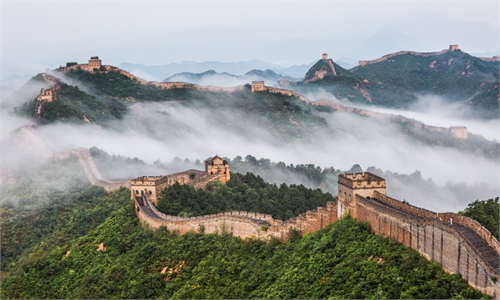ARTS / CULTURE & LEISURE
Villagers living at the foot of Great Wall protect it ‘as if guarding our home’
A symbol of Chinese civilization
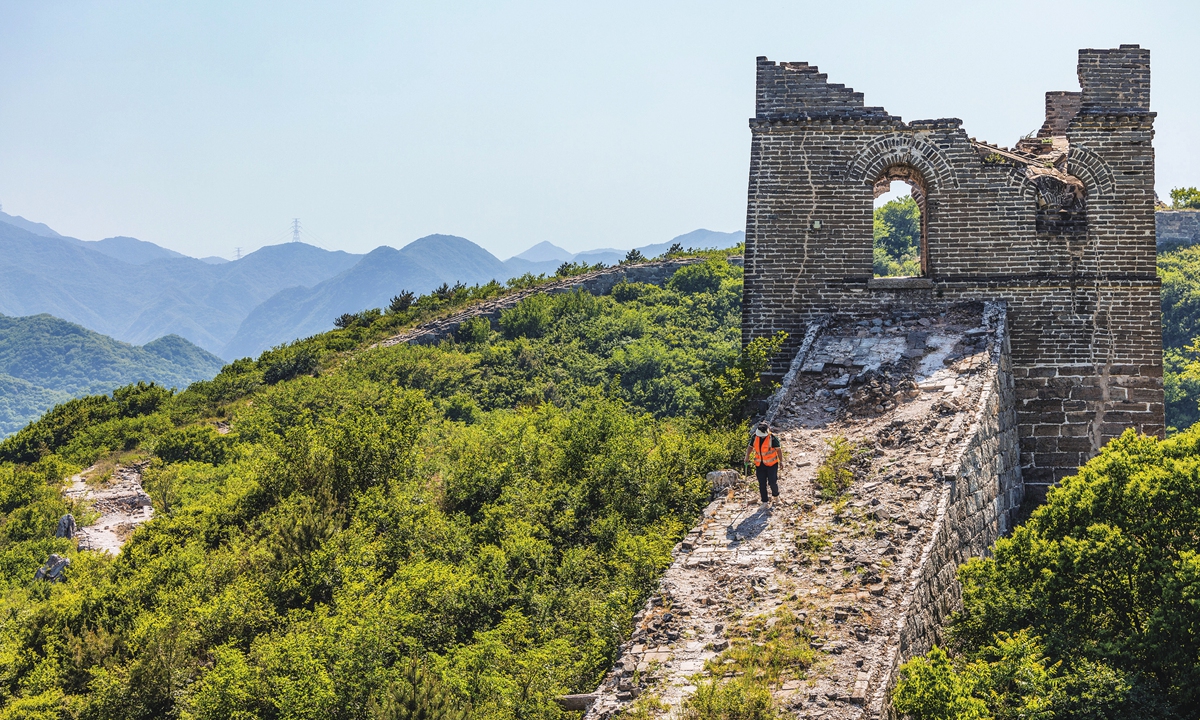
A Great Wall protection team member cleans up garbage on the Badaling Great Wall on May 17, 2024. Photo: Li Hao/GT
Editor's Note:In his response to a recent letter from residents living in Shixia village, Badaling township in Beijing, Chinese President Xi Jinping called for efforts to get more people to learn about the Great Wall and engage more people in its protection in order to pass on this precious heritage to future generations.
The Great Wall is the largest cultural heritage site in China. President Xi has paid great attention to efforts to tap into its cultural value and the inheritance and protection of cultural relics along the Great Wall, issuing multiple instructions on advancing the building of a Great Wall national cultural park.
The Global Times went to Shixia village and talked to experts to learn how local residents have protected the Great Wall and the significance of carrying forward the Great Wall culture.
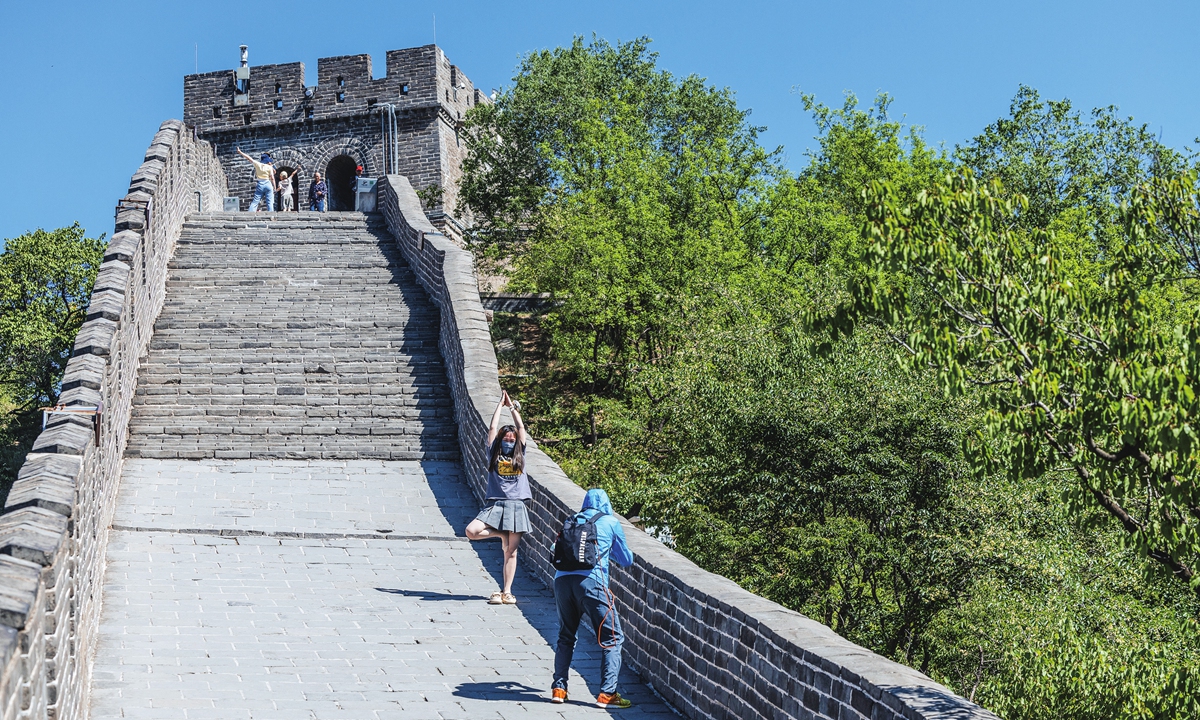
Toursits enjoy themselves on the Badaling Great Wall on May 17, 2024. Photo: Li Hao/GT
On May 17, the residents in a suburban village in Beijing's Yanqing district said that they were overjoyed to receive a reply letter from Chinese President Xi Jinping acknowledging their efforts to protect the Great Wall and encouraging them to pass on this precious heritage to future generations.
President Xi said he was pleased to learn that the villagers had taken the initiative over the years to protect the Great Wall, inherit the Great Wall culture, and rely on its resources on their way to prosperity.
The Great Wall is a representative symbol of the Chinese nation and important symbol of Chinese civilization, Xi wrote in the letter.
"It is our common responsibility to protect and pass on this historical and cultural heritage."
Xi said he hopes that the villagers will continue to protect the Great Wall as they protect their homes, carry forward the Great Wall culture and tell stories about the Great Wall well.
Li Qinghua, Party secretary of Badaling township, told the Global Times that he felt honored to receive the letter from President Xi and was greatly encouraged by his words.
"We also feel a strong sense of responsibility and political mission. As the protection and inheritance of the Great Wall is a tradition of our Chinese nation. For those of us who were born and grew up at the foot of the Great Wall, it is also our undeniable responsibility to carry on this tradition," said Li.
"We will remain committed to our efforts to protect the Great Wall and pass on this time-honored asset to future generations while helping more people understand the culture of the Great Wall," Li Handong, Party secretary of Shixia village, told the Global Times.
Largest cultural heritage site
From the Spring and Autumn Period (770BC-476BC) and the Warring States Period (475BC-221BC) to the Ming and Qing dynasties (1368-1911), the construction of the Great Wall spanned a period of more than 2,000 years. It is the largest and most expansive historical and cultural heritage site in China.
"The Great Wall not only served a military defensive role in history but also played a part in ethnic integration and cultural exchanges," Sun Jiashan, an associate researcher at the Central Academy of Culture and Tourism Administration, told the Global Times on Wednesday.
"It can be said that the Great Wall is both a cultural symbol of the Chinese nation and concrete manifestation of thousands of years of traditional Chinese culture. So no effort in its protection or promotion is too much," Sun said.
Protecting, inheriting and managing cultural relics and heritage, and ensuring the continuity of Chinese culture and the everlasting vitality of the Chinese nation are significant components of Xi Jinping Thought on Culture.
In April, an article by Xi on preserving and passing on cultural heritage and carrying forward fine traditional Chinese culture was published in the Qiushi Journal, a flagship magazine of the Communist Party of China Central Committee.
The article lauds Chinese civilization for its long and continuous history that stretches back to antiquity, saying that it has shaped the great Chinese nation.
Cultural relics and cultural heritage, in particular, carry inherent features of the nation, says the article, which calls them China's "nonrenewable and irreplaceable" cultural resources.
The article says that it is imperative to comprehensively improve the protection and utilization of cultural relics and better preserve and carry forward cultural heritage.
The construction of the Great Wall national cultural park and exploring effective mechanisms for the protection and inheritance of the Great Wall not only effectively develops cultural relics and resources but also helps strengthen the bonds of the Chinese national community consciousness, Sun noted.
In 2021, a dedicated plan outlining the construction of a Great Wall national cultural park was announced, with the building of the relevant parks and infrastructure to be completed by 2035 alongside a comprehensive system for their preservation and use.
President Xi said he was pleased to learn that the villagers had taken the initiative over the years to protect the Great Wall, inherit the Great Wall culture, and rely on its resources on their way to prosperity.
The Great Wall is a representative symbol of the Chinese nation and important symbol of Chinese civilization, Xi wrote in the letter.
"It is our common responsibility to protect and pass on this historical and cultural heritage."
Xi said he hopes that the villagers will continue to protect the Great Wall as they protect their homes, carry forward the Great Wall culture and tell stories about the Great Wall well.
Li Qinghua, Party secretary of Badaling township, told the Global Times that he felt honored to receive the letter from President Xi and was greatly encouraged by his words.
"We also feel a strong sense of responsibility and political mission. As the protection and inheritance of the Great Wall is a tradition of our Chinese nation. For those of us who were born and grew up at the foot of the Great Wall, it is also our undeniable responsibility to carry on this tradition," said Li.
"We will remain committed to our efforts to protect the Great Wall and pass on this time-honored asset to future generations while helping more people understand the culture of the Great Wall," Li Handong, Party secretary of Shixia village, told the Global Times.
Largest cultural heritage site
From the Spring and Autumn Period (770BC-476BC) and the Warring States Period (475BC-221BC) to the Ming and Qing dynasties (1368-1911), the construction of the Great Wall spanned a period of more than 2,000 years. It is the largest and most expansive historical and cultural heritage site in China.
"The Great Wall not only served a military defensive role in history but also played a part in ethnic integration and cultural exchanges," Sun Jiashan, an associate researcher at the Central Academy of Culture and Tourism Administration, told the Global Times on Wednesday.
"It can be said that the Great Wall is both a cultural symbol of the Chinese nation and concrete manifestation of thousands of years of traditional Chinese culture. So no effort in its protection or promotion is too much," Sun said.
Protecting, inheriting and managing cultural relics and heritage, and ensuring the continuity of Chinese culture and the everlasting vitality of the Chinese nation are significant components of Xi Jinping Thought on Culture.
In April, an article by Xi on preserving and passing on cultural heritage and carrying forward fine traditional Chinese culture was published in the Qiushi Journal, a flagship magazine of the Communist Party of China Central Committee.
The article lauds Chinese civilization for its long and continuous history that stretches back to antiquity, saying that it has shaped the great Chinese nation.
Cultural relics and cultural heritage, in particular, carry inherent features of the nation, says the article, which calls them China's "nonrenewable and irreplaceable" cultural resources.
The article says that it is imperative to comprehensively improve the protection and utilization of cultural relics and better preserve and carry forward cultural heritage.
The construction of the Great Wall national cultural park and exploring effective mechanisms for the protection and inheritance of the Great Wall not only effectively develops cultural relics and resources but also helps strengthen the bonds of the Chinese national community consciousness, Sun noted.
In 2021, a dedicated plan outlining the construction of a Great Wall national cultural park was announced, with the building of the relevant parks and infrastructure to be completed by 2035 alongside a comprehensive system for their preservation and use.
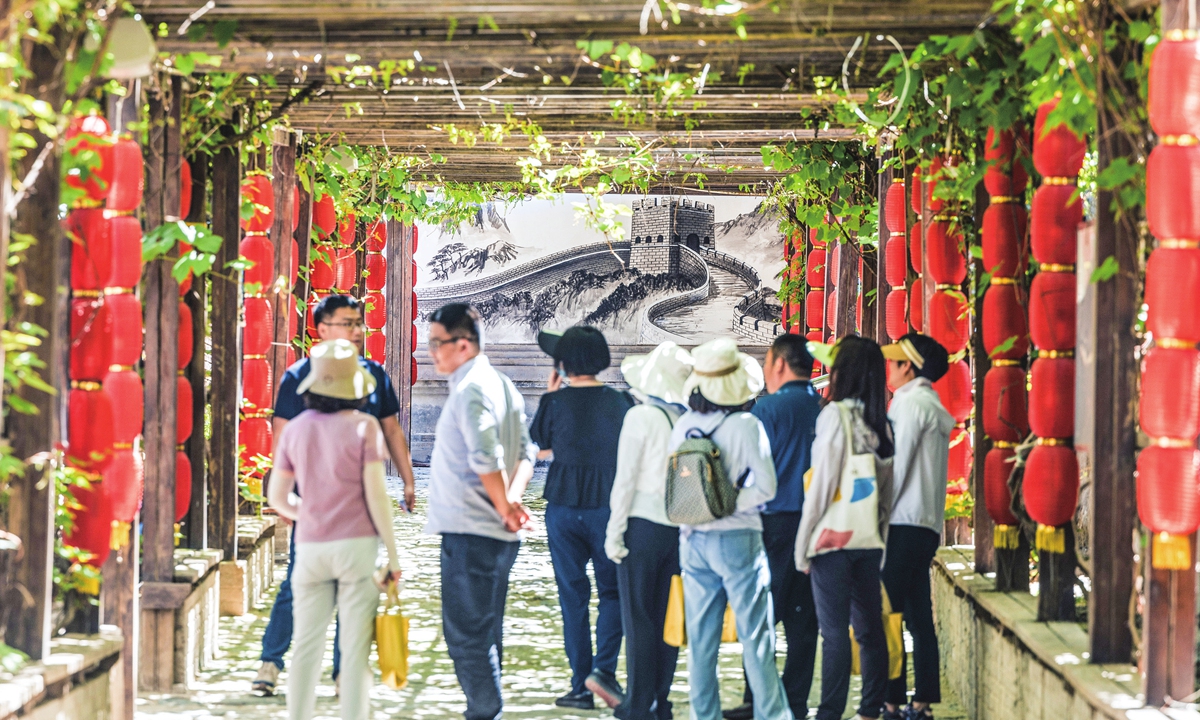
People visit Shixia village at the foot of the Badaling Great Wall on May 17, 2024. Photo: Li Hao/GT
New benchmarkOn the 30th anniversary of an initiative to protect China's largest cultural heritage site, the villagers' letter was a renewed effort in carrying on their commitment to protecting the Great Wall, which also set the villagers on the path to prosperity through years of tourism development.
Possessing a length of the wall stretching over a distance of 179.2 kilometers, the Yanqing district boasts the longest section of the Great Wall with the most magnificent view in Beijing, according to the district government of Yanqing. It includes a world-renowned tourist attraction and UNESCO World Heritage site, the Badaling section of the Great Wall, and many untapped stone and brick sections that continue to thrive thanks to constant maintenance and preservation.
By the end of 2023, Yanqing had carried out more than 50 Great Wall emergency protection projects, repairing 19 castles, 22,247.96 meters of wall, 106 platforms, and 10 beacon towers. The emergency repair rate of the brick and stone sections of the Great Wall has reached 88 percent. The plan for the next three years is to repair 3,700 meters of key sections of the Great Wall and five platforms, to ensure that the entire brick and stone sections of the Great Wall are free of danger and achieve a 100 percent rate for handling other dangers to the Great Wall, according to local authorities.
Liu Manli, a vice director of the Yanqing District Cultural Heritage Bureau, told the Global Times that protection of the Great Wall is the cornerstone of the inheritance and promotion of the Great Wall culture.
"Currently, in the Yanqing district, emergency repairs and maintenance have restored more than 20 kilometers of the Great Wall with a total investment of 360 million yuan [$50.77 million]," Liu said.
"By utilizing multiple cutting-edge technologies, we are systematically advancing the protection of the Great Wall, setting a new benchmark for the conservation of Great Wall heritage. In terms of digital technology applications, we have completed a three-dimensional model of the entire Great Wall in the region, achieving a precision of up to two centimeters," Liu noted.
"We have implemented regular unmanned aerial drone patrols and online diagnoses and treatment of dangers to the Great Wall, and pioneering digital protection of the Great Wall in China," Liu added.
Bi Jianyu, director of cultural heritage protection department of Beijing Municipal Cultural Heritage Bureau, told the Global Times that they have established a team of nearly 500 Great Wall protectors, ensuring that there is dedicated personnel for patrolling and guarding every kilometer of the Great Wall.
"We also prioritize the use of high-tech methods for Great Wall conservation, such as applying micro-trace extraction techniques. Next step, we plan to utilize remote sensing technology for disaster monitoring and early warning along the Great Wall next year, further enhancing the Great Wall protection," Bi said.
A Great Wall protection team was established in 2019. Currently, a total of 20 team members in Badaling township take turns to patrol the unopened sections of the man-made defensive structure built during the Ming Dynasty (1368-1644).
"Our daily patrols involve monitoring potential risks, cleaning garbage, recording 'ailments' along the wall and advising tourists against actions that may pose a risk to the Great Wall," Mei Lanfen, one member of the team, told the Global Times after navigating a dirt path littered with thorny bushes to the top of a tower in Shixia village.
During Xi's visit to Jiayu Pass, a famed part of the Great Wall in Northwest China's Gansu Province in 2019, he stressed that the Great Wall, as well as the Yangtze and the Yellow rivers, are all important symbols of the Chinese nation and the spirit of the nation.
"We must attach importance to the efforts in keeping our history and culture alive and strong to preserve our roots for the survival and thriving of the Chinese ethos," Xi said.
For generations, local villagers in Shixia have voluntarily engaged in the protection of the Great Wall.
"I've developed a profound affection for the Great Wall since childhood. It has become a habit for our villagers to clean up trash and persuade tourists not to climb the unopened sections," 71-year-old villager Gu Tongfu told the Global Times.
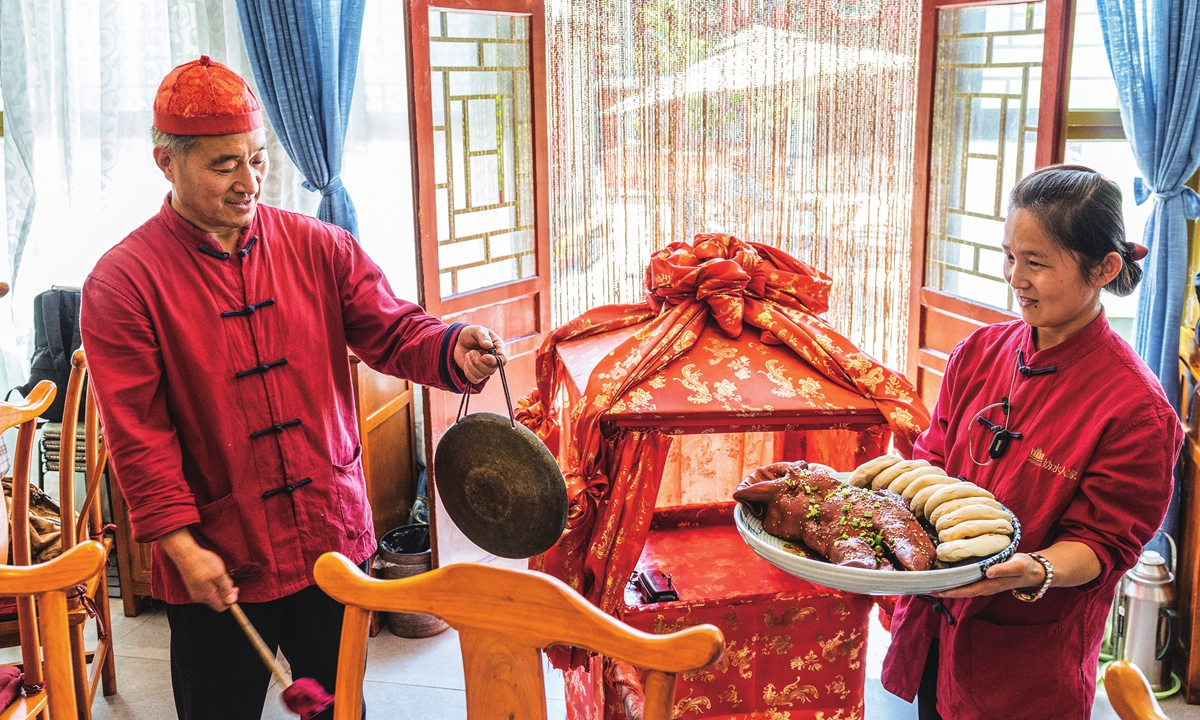
A villager in Shixia village at the foot of the Badaling Great Wall brings local food to guests on May 17, 2024. Photo: Li Hao/GT
A better lifeThe villagers have also reaped rewards for their efforts as the development of the Great Wall tourism industry, represented by branded homestays, has driven local economic growth, leading to a significant increase in villager income.
In the past, villagers could only rely on selling corn and local specialties to earn a meager income. Now, with tourism, homestays, and catering, the village hosts over 40,000 tourists each year. The cultural resources at the Great Wall have paved the way for local villagers to lead a better life, according to Li Handong.
Li Qinghua said that the next step is to transform the resources of the Great Wall into concrete measures for rural revitalization.
"We plan to create a sweeping Great Wall scenic area that combines the Badaling section with the neighboring sections, improve transportation facilities and establish new climbing and riding trails," said Li Qinghua.
Hou Lin, a deputy director of the Yanqing District Bureau of Culture and Tourism, told the Global Times that Yanqing will continuously explore the cultural resources of the Great Wall, promote and inherit the culture of the Great Wall and create unique cultural and tourism products, burnishing the reputation of the Badaling Great Wall as a world-class icon.
"We will continue to hold cultural events themed around the Great Wall, such as the ongoing Beijing Great Wall Concert and Great Wall Cultural Festival, to promote the profound history and cultural heritage of the Great Wall," said Hou.
